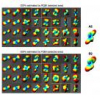Free Online Productivity Tools
i2Speak
i2Symbol
i2OCR
iTex2Img
iWeb2Print
iWeb2Shot
i2Type
iPdf2Split
iPdf2Merge
i2Bopomofo
i2Arabic
i2Style
i2Image
i2PDF
iLatex2Rtf
Sci2ools
ISBI
2008
IEEE
2008
IEEE
On approximation of orientation distributions by means of spherical ridgelets
Visualization and analysis of the micro-architecture of brain parenchyma by means of magnetic resonance imaging is nowadays believed to be one of the most powerful tools used for the assessment of various cerebral conditions as well as for understanding the intracerebral connectivity. Unfortunately, the conventional diffusion tensor imaging (DTI) used for estimating the local orientations of neural fibers, is incapable of performing reliably in the situations when a voxel of interest accommodates multiple fiber tracts. In this case, a much more accurate analysis is possible using the high angular resolution diffusion imaging (HARDI) that represents local diffusion by its apparent coefficients measured as a discrete function of spatial orientations. In this note, a novel approach to enhancing and modeling the HARDI signals using multiresolution bases of spherical ridgelets is presented. In addition to its desirable properties of being adaptive, sparsifying, and efficiently computable, ...
Angular Resolution Diffusion | Conventional Diffusion Tensor | ISBI 2008 | Magnetic Resonance Imaging | Medical Imaging |
Related Content
| Added | 20 Nov 2009 |
| Updated | 20 Nov 2009 |
| Type | Conference |
| Year | 2008 |
| Where | ISBI |
| Authors | Oleg V. Michailovich, Yogesh Rathi |
Comments (0)

